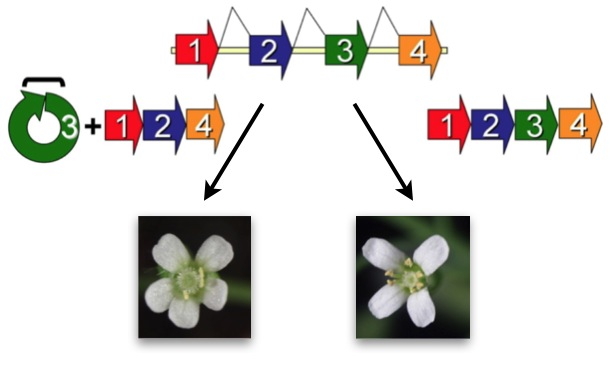One of the most surprising discoveries of whole genome sequencing is the seemly insufficient number of genes to explain the stunning diversity of living organisms. To overcome this genetic parsimony, eukaryotes have adapted alternative splicing of pre-mRNA. This strategy gives rise to multiple coding mRNA transcripts from the same gene, resulting in at least a four-fold expansion of the functional proteome. Over 95% of human genes and from 30-60% of Arabidopsis genes are alternatively spliced (AS). AS is thus a key component in all life processes in higher organisms, however the mechanisms and regulation underlying AS remain poorly understood.
Recently, a novel form of mainly non-coding RNA arising from AS, circular RNA (circRNA), has been identified. CircRNAs are stable and long-lived RNA molecules with unknown function. We have identified in Arabidopsis a number of these alternative-spliced circRNAs and demonstrate that at least of them has the ability to regulate splicing of its parental gene.
To do this, we overexpressed a specific circRNA from a gene that plays an essential role in flowering and floral organ development (
SEPALLATA3 gene) and they demonstrated that it was capable of modifying the levels of mRNA encoding different isoforms of the parental transcript. In addition, mRNA levels were not only modified by this circRNA, but its overexpression also gave rise to a floral phenotype consisting of an increase in the number of petals and a decrease in the number of stamens in an Arabidopsis flower (
Figure).
This work shows for the first time that circRNAs can have dramatic developmental consequences for an organism and suggests that circRNAs are new and potent gene regulators which until now have been « under the radar ».
circRNAs are not just important in plants, but have been shown to be key regulators in mammalian cells and diseases such as cancer. This work opens up new avenues of investigation in gene regulation and alternative splicing with applications from basic research to targeted therapeutics.

Alternative splicing generates linear and circular RNAs.
A gene with four splice sites is presented.
on the left, an alternative splicing generates a circRNA (in green) and a linear mRNA (in red, blue, orange) or
on the right, a canonical splicing generates a linear transcript (in red, blue, green, orange).
The overexpression of the circRNA resulted in a phenotype with supernumerary petals (bottom left), unlike the wild flowers presented at the bottom right with four petals.